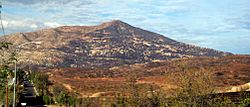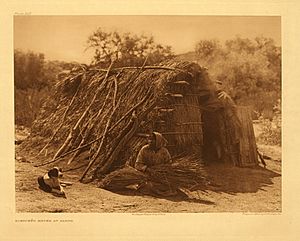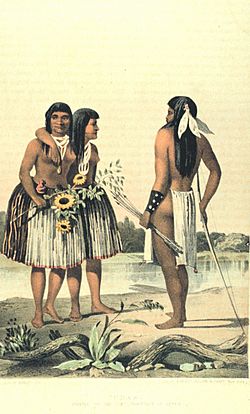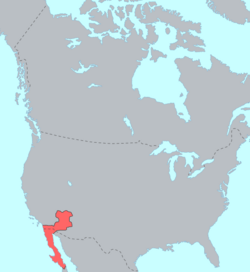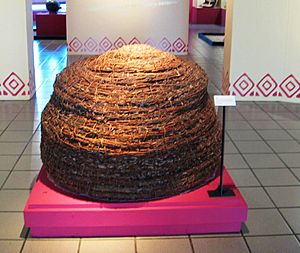El Vallecito facts for kids
Quick facts for kids Kumeyaay Culture – Archaeological Site |
||

Kumeyaay coiled basket, woven by Celestine Lachapa, 19th century, San Diego Museum of Man
|
||
| Name: | El Cerrito | |
| Type | Mesoamerican archaeology | |
| Location | La Rumorosa, Tecate Municipality, Baja California |
|
| Region | Aridoamerica | |
| Coordinates | 32°31′0″N 116°14′53″W / 32.51667°N 116.24806°W | |
| Culture | Kumeyaay (Spanish:Kumiai) | |
| Language | Kumeyaay | |
| Chronology | 1000 BCE | |
| Period | Prehistory | |
| INAH Web Page | El Vallecito, INAH Web Page | |
El Vallecito is an important archaeological site. It is located near the city of La Rumorosa in Baja California, Mexico.
People have lived in Baja California for thousands of years. Evidence shows that humans were here as early as 8000 BCE. Some sites are more recent, about a thousand years old. However, the rock carvings, which are stronger, could be even older.
The Kumeyaay people lived in this area. Their land stretched from Santo Tomas in Baja California to the San Diego coast in California. It also included mountains and deserts in northern Baja California. This included the Laguna Salada area and part of the Sierra Juarez mountains.
This site has more than 18 groups of cave paintings. Only six of these can be visited by people today. El Vallecito is considered one of the most important sites in the region.
The site has many cave paintings and carvings made by ancient people. These early groups were nomads, meaning they moved from place to place. They hunted animals and gathered fruits, seeds, roots, and seafood to live.
The rocks are decorated with white, black, and red figures. These pictures were made about three thousand years ago. At that time, different groups, like the Yuman or Quechan people, moved into Baja California from what is now the United States.
Contents
History of the Kumeyaay People
About fourteen thousand years ago, the first nomadic groups arrived in this area. They traveled along the Pacific Ocean coast. These early people lived by finding food from nature.
During ancient times, there were three main tribal groups. These were the Pericúes, Guaycuras, and Cochimíes. The Pericúes lived in the south of the peninsula. The Guaycuras lived in the middle. The Cochimíes lived in the northern part.
Alongside the Cochimíes, other nomadic groups lived there. These included the Kumeyaay (K'miai) people. They were one of the native families in northern Baja California. Other related groups were the Cucapá, Paipai, Kiliwa, Cahilla, and Akula. All these groups belonged to the larger Yuman family.
Understanding Kumeyaay Culture
The ancient people were nomads who hunted and gathered food. Over time, they formed different groups. Each group had its own territory where they searched for food. They used the natural resources around them.
The Kumeyaay were among the first settlers. They lived from the coast to the mountains. They gathered fruits and seeds like acorns, pine nuts, and manzanita. These plants still grow in the region today. People use them as medicinal plants.
The Yuman People
The Yumans, also called Quechan, were ancestors of many local groups. These include the Cucapá, Kiliwa, Pai-pai, and Kumeyaay. They moved into the Baja California peninsula from the north. They played a very important role in how people spread out in the region.
- The Cucapá lived in the Mexicali area and near the Colorado River. They did some farming when rivers flooded. They also hunted and gathered food.
- The Kiliwa, Pai-pai, and Kumeyaay lived in the mountains and valleys of Baja California.
Yuman Languages Spoken Today
The Yuman–Cochimí language family includes several languages. They are spoken in Baja California and northern Sonora in Mexico. They are also spoken in southern California and western Arizona in the USA.
The Cochimí language is now extinct. Cucapá is the Spanish name for the Cocopa people. Diegueño is the Spanish name for the Ipai/Kumeyaay/Tipai people. Today, they are often called Kumeyaay. Upland Yuman includes several dialects that are similar enough for speakers to understand each other. These are spoken by the Yavapai, Hualapai, and Havasupai groups.
More About Kumeyaay Culture

The Kumeyaay are also known as Tipai-Ipai, Kamia, or Diegueño. They are Native American people. They live in the southwestern United States and northwest Mexico. You can find them in California (USA) and Baja California (Mexico). In Spanish, their name is often spelled Kumiai.
The Kumeyaay have two related groups: the Ipai and the Tipai. The San Diego River roughly separated their traditional lands. The northern Ipai lived from Escondido to Lake Henshaw. The southern Tipai lived in areas like the Laguna Mountains, Ensenada, and Tecate.
The meaning of the name Kumeyaay is not fully known. However, Ipai or Tipai both mean "people." Some Kumeyaay in the southern areas call themselves MuttTipi, which means "people of the earth."
People have lived in Kumeyaay territory for at least 12,000 years. Around 7000 BCE, two main cultural ways of life appeared. These were the California Coast and Valley tradition and the Desert tradition. The historic Tipai-Ipai groups appeared around 1000 CE. However, some say Kumeyaay people have been in the San Diego area for 12,000 years. When Europeans first arrived, the Kumeyaay had many independent groups. These groups were made up of about 30 family clans.
The Kumeyaay people used to support themselves by farming. They also worked in agriculture for wages. But a 20-year drought in the mid-1900s hurt their farming economy. For their common good, several reservations formed a non-profit group called Kumeyaay, Inc.
The Kiliwa, Pai-pai, and Kumeyaay lived in the mountains and valleys of Baja California. They used resources from both the coast and the mountains. They made pottery and baskets. Archaeologists find their pottery and many mortars carved into rocks.
Today, there are Kumeyaay descendants in Mexico. They live in mountain areas like San Jose in Tecate, San Jose de la Zorra, and Juntas de Nejí.
The Kumeyaay Language
There are different ideas about how to name and separate the Kumeyaay languages. Most experts agree on three separate languages: Ipai, Kumeyaay proper (including Kamia), and Tipai in northern Baja California. However, the Kumeyaay people themselves say that all Kumeyaay (Ipai/Tipai) can understand each other. This is true at least after a short time of getting used to the different ways of speaking. All three languages belong to the Delta–California branch of the Yuman language family. Other related groups in this family include the Cocopa, Quechan, Paipai, and Kiliwa.
Exploring the El Vallecito Site
The presence of the Kumeyaay people is clear from the many drawings. These drawings are on the walls and ceilings of rock shelters. They are also on the outside of large stone blocks. These places were used as seasonal camps. They were also used for making stone tools or for working with seashells.
The area is known for its many cave paintings. The paintings are made on rock surfaces. Most of them are found inside rocky shelters. Some of these paintings have special meanings related to myths or religion.
At this archaeological site, more than 30 sets of drawings have been found. However, only six of them are open for visitors to see.
Many drawings follow the natural shape of the rock. The most common colors are red (in different shades), black, and white. The colors came from minerals. These minerals were ground into powder and mixed with something to make paint. The artists used a type of brush to apply the paint.
Amazing Petroglyphs at El Vallecito
At the archaeological site of El Vallecito, you can currently see the following special rock art sets:
El Tiburón (The Shark)
The "shark" is the first interesting spot you'll see. It's a large granite rock that looks like a shark's head from the outside. Inside, there's a black figure that looks like a flying butterfly. Around it, you can see several mortars carved into the rock.
El Solsticio or El Diablito (The Solstice or The Little Devil)
The "Solstice" or "El Diablito" is probably the most important part of the site. It might have been used for special ceremonies.
This shelter is part of a rock wall. It has a small red figure that looks like a person. It has what seem to be antennas on its head and small black eyes. This figure is about 33 centimeters tall. It is surrounded by geometric shapes and other human-like figures in black and white.
A truly amazing thing happens here on December 21st and 22nd. A ray of sunlight shines directly onto the figure's eyes. It lights up the inside of the shelter for a few minutes. This event is a solstice marker. It shows the start of winter in the northern hemisphere. This was a very special date in the Kumeyaay calendar.
El Hombre Enraizado (The Rooted Man)
The "rooted man" is a small group of rocks. It has two panels with white figures. The first panel has a geometric pattern with five lines. These lines end in circular points. The second panel is a small hollow. It has a human-like figure with something that looks like roots or limbs hanging down. There are also a few other small figures nearby.
La Cueva del Indio (The Indian Cave)
The "Indian cave" must have been very important to the people who lived there. It has many mortars, grinding stones (metates), pottery pieces, and stone waste from making tools. It's a large granite dome that looks like a mushroom. It has paintings on its walls and ceiling, on both the north and south sides.
The north side has many images in red, white, and black. The most noticeable designs are human-like figures, circles within circles, and lines that stretch across the roof. There are also some spots.
The south panel mostly has white designs. These are very simple human figures, some with three heads. There are also circles and other geometric shapes. The figures are made using a simple outline technique.
Los Solecitos or Wittinñur (The Little Suns or Painted Rock)
In the Kumeyaay language, Wittinñur means "painted rock." Like the previous cave, it has drawings on its walls and ceiling. Its exact meaning is not known.
El Caracol (The Snail)
This group of rocks fits beautifully with the landscape. It has a large number of red paintings.
You'll notice many elements on the walls and ceiling. They are made in different shades of red and black. The artists used the natural rock formations. There are small suns (solecitos) drawn in small hollows. Part of this area stands out because it has a rock with more than a dozen mortars. There are also other small depressions or dimples. These might have been used for rituals, showing a sense of balance in the shapes displayed.
See also
 In Spanish: El Vallecito (Baja California) para niños
In Spanish: El Vallecito (Baja California) para niños


